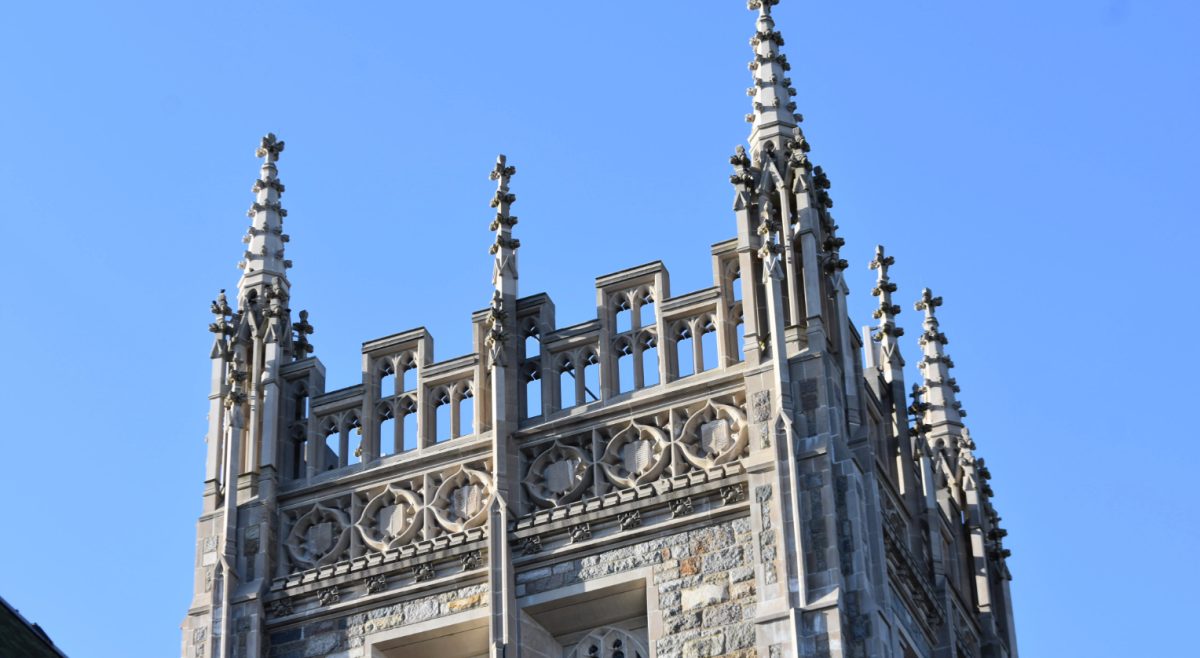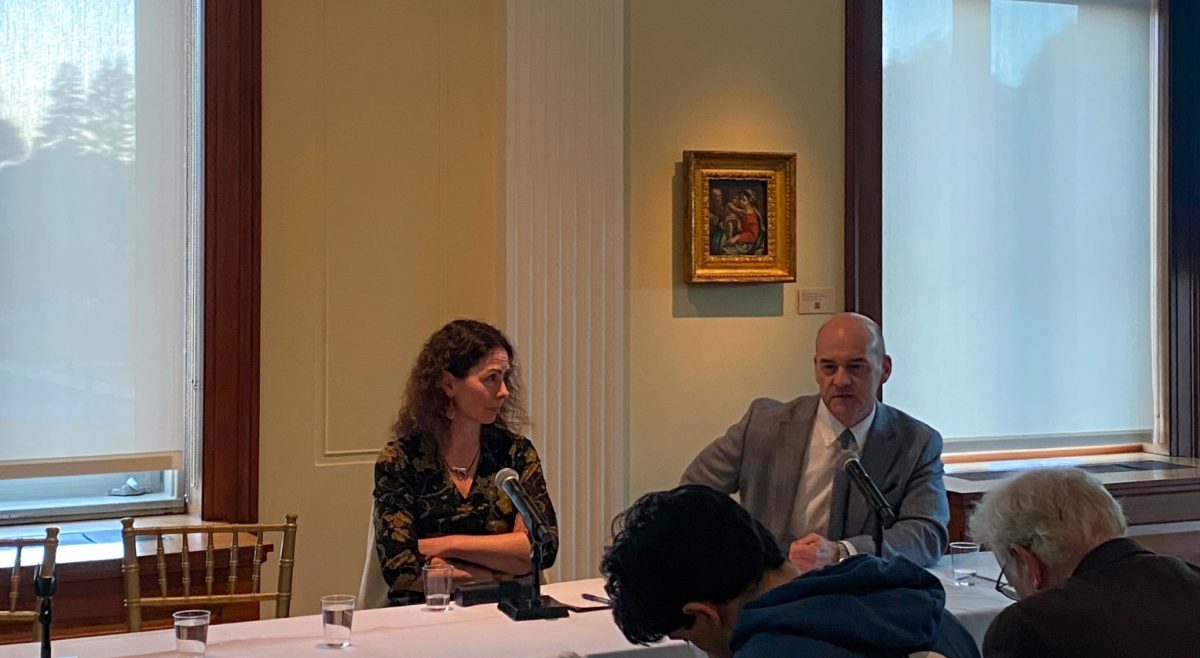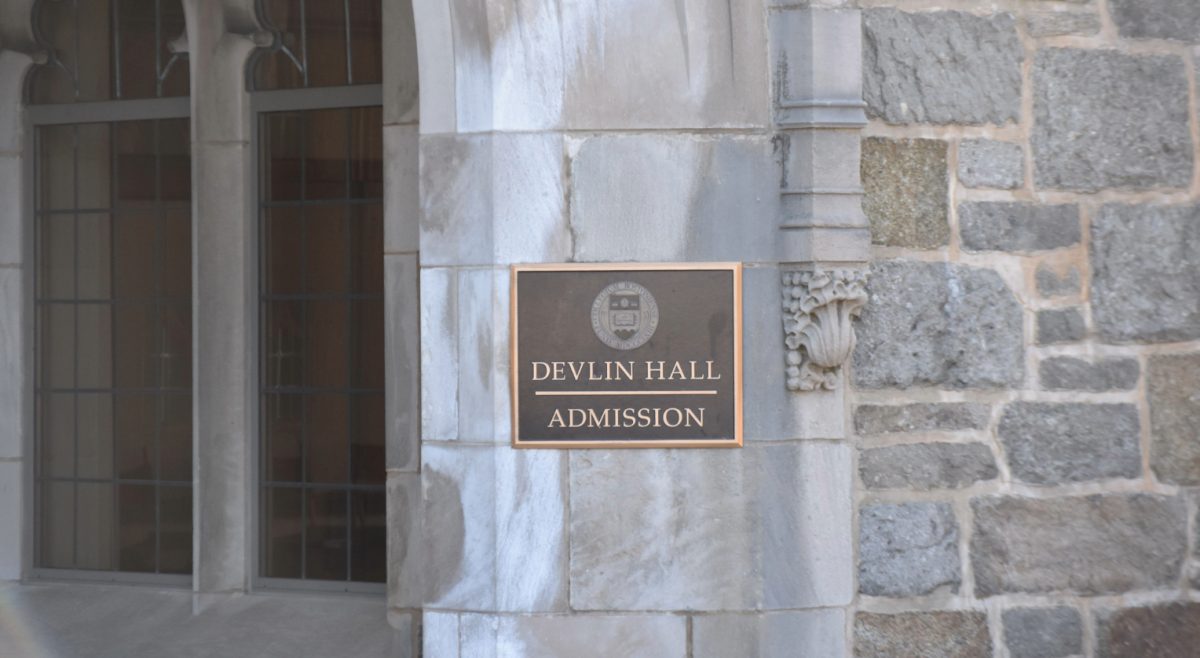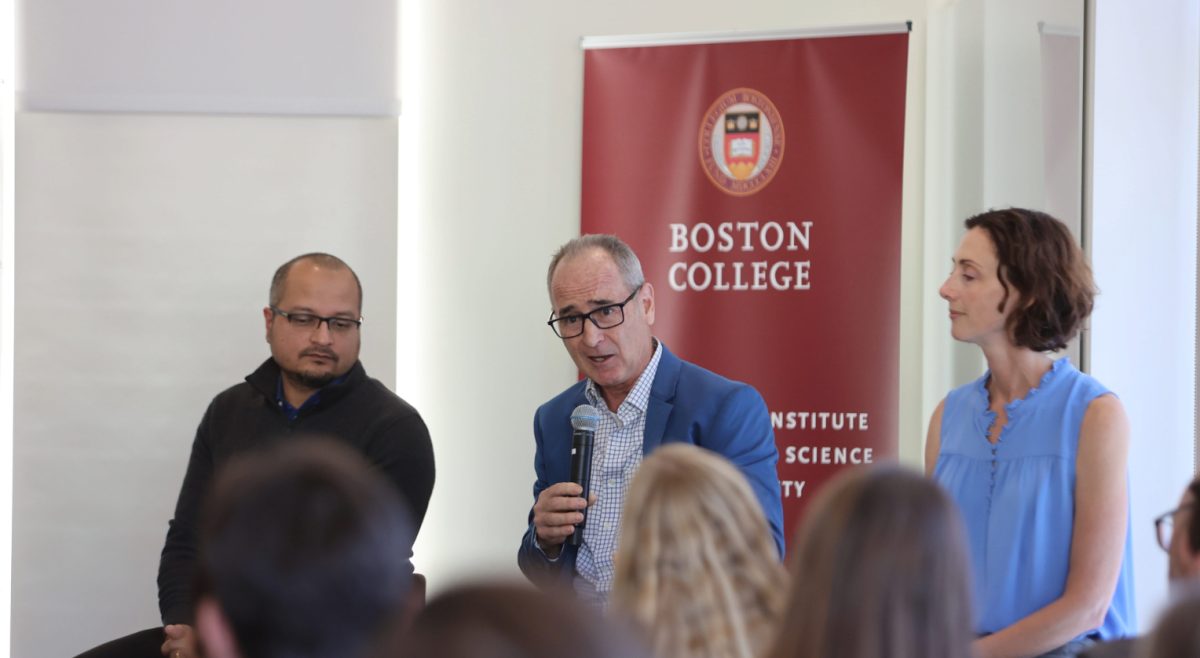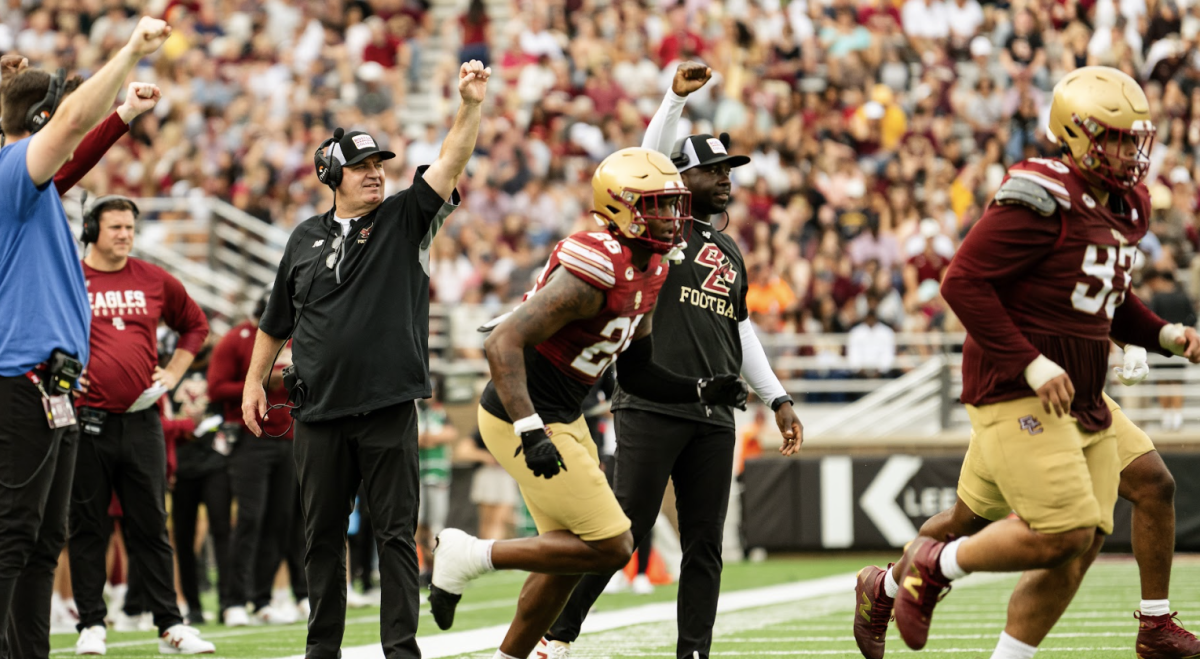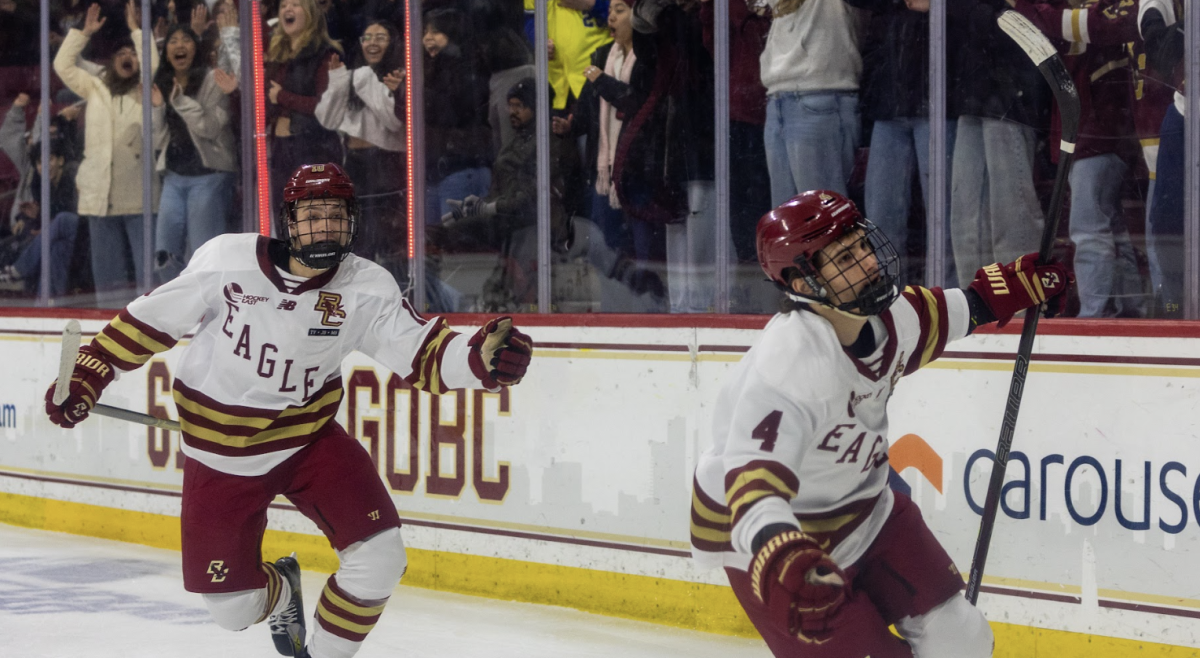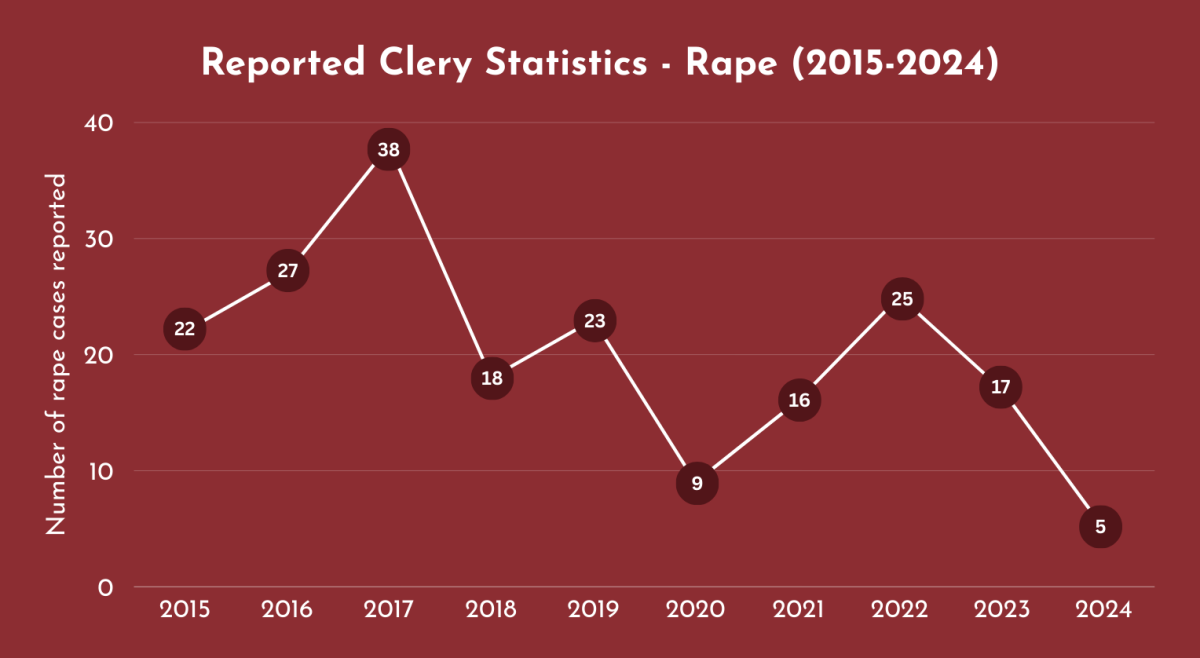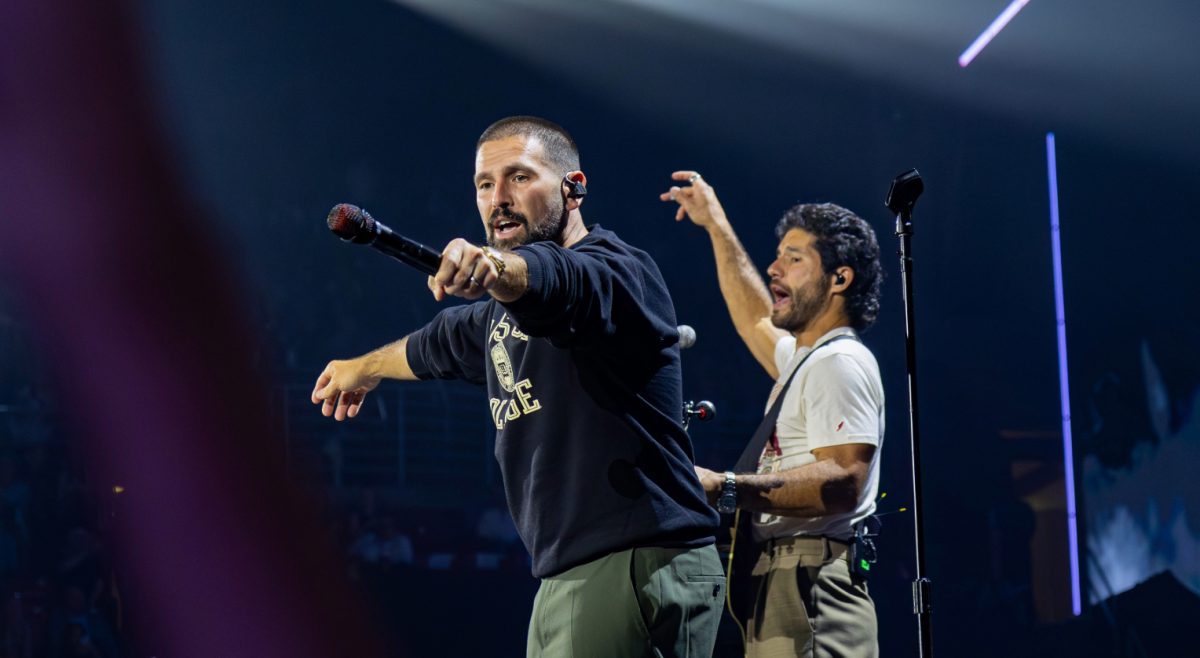In 2005, nine years into his term as the 25th president of Boston College, University President Rev. William P. Leahy, S.J., addressed faculty and administration at the yearly Convocation, like he does every year. That year, he spoke about the next phase in the University’s development, focusing on three points: “where we have come from,” “where should we be going,” and “what will our future be.” Leahy pointed out the academic growth, geographic diversity, and increase in students who identify as AHANA.
“We are a success story in American higher education,” he said at the time.
In the 10 years prior, and the 10 years after that statement, the University has grown academically, physically, and—more slowly and begrudgingly—socially, all the while led by a president that can be hard to pin down. More than one administrator has said that Leahy never stops being president of BC, putting in 100 hours each week. Leahy, administrators have said, never forgets what his goals are—through and through, he is unwaveringly, singlemindedly committed to the University. Yet, through protests, columns, and letters to the editor in The Heights, many students in the last two decades have noted Leahy’s inaccessibility to the student body.
This fall marks Leahy’s 20th year as the president of the University. This is what has changed.
(Leahy declined a request for an interview submitted via the Office of News & Public Affairs. He also declined interview requests about his 20th anniversary from Boston College Magazine and the Office of News & Public Affairs.)
In 1996, Leahy arrived at BC from his former position as executive vice president at Marquette University. Back then, the acceptance rate for incoming freshmen was 37 percent. Since then, the applicant pool has increased from 16,680 to 29,486, and the acceptance rate has dropped to as low as 29 percent. But even before that, John Mahoney was here. In 1990, he became the director of the Office of Undergraduate Admission, a position he has held ever since.
Mahoney cited three key reasons for BC’s rise in the academic world since 1996. First, the academic reputation has improved. With the 1999 arrival of Alan Wolfe, a political science professor who Mahoney described as a “public intellectual,” and the 2001 hiring of prolific author Juliet Schor to teach in the sociology department, the University became a destination for faculty members. Wolfe was the first director of the Boisi Center for Religious and Public Life, and had been at Boston University before coming to BC.
“The impact, in so many ways, put Boston College on the map as a powerful academic institution,” Mahoney said.
The relationship between the applicant pool and the academic reputation of the faculty is something of a chicken and egg situation: with better faculty come more qualified students, and with more qualified students, the academic reputation of a school increases, and more faculty are inclined to come.
“We’re attracting a larger applicant pool. We’re attracting a more qualified applicant pool,” he said. “We are enrolling a more talented student body today than 20 years ago.”
Mahoney noted some other things that have upped the academic quality of the school in the last 20 years. The Institute for the Liberal Arts, begun in 2008, funds interdisciplinary, unique projects like Joycestick, a multidisciplinary effort to create a virtual reality video game. And in 2015, the Shea Center for Entrepreneurship opened its doors to students interested in a career at a startup.
But it takes more than brilliant faculty and niche centers for a University to climb up in the rankings. What it takes to draw students in is a picture-perfect, coordinated, social media-ready campus. And that is exactly what Leahy wanted to accomplish. Mahoney points to the expanded physical campus as an important factor in the more competitive admissions process. Under Leahy’s tenure, Maloney Hall and Stokes Hall were both built. In Stokes, amid the gleaming wood and buzzing chatter from the cafe, tour guides typically pause to talk to their groups about the benefits of BC’s rigorous liberal arts education. The building is a hallmark for BC’s commitment to the liberal arts, and an attractive one. Higgins Hall, a centerpiece for many science and nursing classes, has also been renovated, and so has Gasson Hall, the University’s trademark. These renovations were part of the 10-Year Master Plan that began in 2008.
The third element Mahoney noted is BC’s religious grounding. The Center for Ignatian Spirituality, established in 1997, helped to foster an increased religious consciousness on campus. He said that as BC becomes stronger academically, it is critical that its Jesuit values are not left behind. Former University President J. Donald Monan, S.J. was the architect of the modern BC, Mahoney said, and Leahy was the builder.
“It’s Father Leahy talking to upper-level admin, and talking to trustees and all of that wisdom has to be collected, priorities have to be set, fundraising goals have to be established,” he said. “He’s the nexus … decision-making has to happen at that very high level to determine what direction we want to go in, how we want to achieve excellence.”
But the rigorous academics, postcard campus, and core morals will only go so far if the Admission Office can’t reach potential applicants. So, in the last two decades, under the directorship of Mahoney, things have changed.
A broader applicant pool necessitates a broader geographical area from which to pull students. Between the early 1990s and about 2010, the Admissions Office particularly pushed to recruit more students from the western and southern states. Recruiters also travel to Asia, Europe, and South America to entice foreign students, whose numbers have nearly doubled as a proportion of the student body. They have also begun to recruit more aggressively on social media with a partnership with the Office from News and Public Affairs.
The efforts have paid off: the median SAT score of a BC student has gone from between 1150 and 1300, in 1996, to between 1300 and 1440, in 2016. There were 24 faculty chairs in 1996, and 84 now. Three and a half percent of students were international in 1996, and now international students make up 6.1 percent of the total student body. Alumni chapters have sprung up in Sao Paulo; Madrid; Riyadh, Saudi Arabia; and Tokyo, among other cities.
And as the University continues to grow and to attract the best and brightest students from around the country and the world, it has jumped up in the rankings. From 37 to 30 in the U.S. News and World Report represents a significant jump, Mahoney said. It might be harder to get up into the top 25 or even 30: those schools in the elite category tend to stay in the same position. These schools have long-established, powerful academic reputations and larger endowments, which presents a particular challenge to the Office of Admissions.
“We are the window to the University, to so many people,” he said.
BC’s Light the World campaign exceeded its $1.5 billion goal this June, and reached $1.6 billion, the highest amount of money raised in a campaign since the University’s inception. Light the World raised more than triple the amount of money of the last financial campaign—Ever to Excel, which ran from 1997 to 2003, raised a comparatively paltry $441 million. One hundred forty thousand parents, alumni, and friends contributed to the campaign, which began in 2008. The two capital campaigns that ran during Leahy’s presidency raised over $2.41 billion combined.
Georgetown University is BC’s biggest rival for applicants. Its last capital campaign, which ended this October, also raised about $1.6 billion, though it began in 2006.
BC’s successful campaign designates its funds to specific divisions: academic excellence, financial aid, Jesuit Catholic heritage and student formation, athletics, facilities, annual giving, and a category for donations that are pending designation. Some of the categories were overshot, notably athletics, which raised over $136 million, well above its original goal of $100 million.
From this campaign, $247 million will go to financial aid.
In 2005, Leahy noted that one of his goals was to grow the endowment, which in 1996, upon his arrival, stood at $600 million. Now, the endowment is at $2.2 billion, significantly over Georgetown’s $1.5 billion. The endowment provides support for BC’s institutional success—money from it goes toward research, faculty chairs, and student formation programs. The money from Light the World is distinct from the endowment.
Despite the fundraising successes of the University, Senior Vice President for University Advancement James Husson noted that there is still work that could be done. He hopes to get more alumni donating yearly to the University. Right now, about 85 percent of seniors contribute to the class gift, which is up from 27 percent in 1996. Husson did not disclose the number of alumni who contributed to the capital campaign, but noted that one of the challenges faced by the Advancement Office is reaching alumni who are too busy to have an active relationship with BC.
“Our community of alumni, parents and friends were motivated by a desire to partner with the University to achieve these goals and experienced the Campaign as a call to action—a rallying cry that brought us all together to strengthen a University that means so much to so many,” Husson said in an email.
Annual giving reached $128.4 million this past year. When Leahy took over in 1996, $24.7 million was being gifted to the University each year.
The money from the Light the World campaign, and previous ones, make it possible to implement a 10-Year Master Plan. Right now, the University is in the middle of a Master Plan that was first submitted to the city for approval in June 2008. One of the foremost points of the Master Plan involves moving all undergraduates into on-campus housing, which would make the University the first in Boston to do so. Another proposal is the integrated science center, which would augment the scientific research on campus and push the University into a higher academic echelon.
Campus has expanded beyond Main Campus since Leahy’s arrival. Perhaps most significantly, the University acquired the 43 acres that now makes up the Brighton Campus. Formerly the site of Archbishop Cardinal Bernard Law’s residence—now the remodeled McMullen Museum of Art—the purchase was a watershed moment for the University and a necessary symbolic change for victims of the sexual abuse scandal in Boston perpetuated by Law.
In addition, the Yawkey Athletics Center was completed in 2003, the Connors Retreat Center in Dover, Mass., was renovated in 2005, Maloney Hall was completed in 2011, and the Cadigan Alumni Center and Stokes Hall were both completed in 2012. Three buildings finished construction in 2016: 2150 Commonwealth Avenue, 2000 Commonwealth Avenue, and the McMullen Museum.
All told, BC has expanded from 185 acres to 338, and from 90 buildings to 159.
Many of the administrative offices have moved across Commonwealth Avenue to the Brighton Campus, where the School of Theology and Ministry is also located. With the recent acquisition of nine acres of land on Hammond Pond Parkway, more offices are poised to move off of Main Campus, though none have specifically been named.
“To have doubled our size, and to have acquired land that was adjacent to our main campus, was an enormous boon to the growth possibilities for Boston College,” said Vice President for Institutional Research, Planning, and Assessment Kelli Armstrong.
Under Leahy’s administration, planning for the future of the University has taken a more data-centric approach, according to Armstrong, who began at BC 12 years ago as an institutional researcher. Data includes benchmarking peer institutions, showing the demonstrated need for the investment, and mapping outcomes.
The University is constantly in the middle of writing or implementing a strategic plan, with new plans being written in the middle of every decade. When Leahy began as university president in 1996, he was tasked with implementing the strategic plan of the mid ’90s, as part of the University Academic Planning Committee (UAPC). As the University headed into the 21st century, the UAPC sought to develop BC’s academic programs, through the promotion of graduate and professional education in the University and the support of research as central to the mission of BC.
“The council’s recommendations emphasize rigorous intellectual development and personal formation as the distinctive marks of a Boston College undergraduate education,” reads a 1996 issue of The Heights.
Funding from the UAPC allowed for new academic programs that made BC a national competitor with other institutions of higher education.
“The UAPC—that is, the plan of the ’90s—really made us a research university,” said former Vice Provost for Faculties Patricia DeLeeuw. “We have been building on that plan ever since.”
Beyond the implementation of the UAPC, DeLeeuw counts the steady growth in national rank, the creation of Church in the 21st Century Center, the increase in the endowment and number of endowed chairs among the faculty, and the renewed commitment to diversity as key successes of Leahy’s tenure.
“All these marks of a great university have happened during his tenure,” DeLeeuw said.
Now the institutional and financial future of BC rests in the hands of the University Strategic Planning Initiative, which will identify which facets of the University the next capital campaign should focus on. Looking ahead, University Advancement has not yet determined a focus, or even a name, for the next capital campaign.
“We want to follow the lead of the current strategic planning process and take the time to engage our constituencies in those outcomes as they develop,” Husson said. “This dialogue will inform the priorities and timing of the next comprehensive campaign.”
When DeLeeuw began as a faculty member in the theology department in December of 1979, Boston College was a very different institution.
“BC was smaller, and frankly, it felt more like a community, because it was a smaller, less complex place,” DeLeeuw said. “Fondly, we called it a ‘mom-and-pop’ operation. It was more sophisticated than that, but it had that kind of mom-and-pop feeling about it.”
Similarly, Sharlene Hesse-Biber joined the faculty in the late 1970s, as a demographer and assistant professor in the sociology department. For Hesse-Biber, the University presented a chilly climate for women and minorities.
At that time, the University was a regional school, made up of mostly commuter students from the New England area and faculty who, in most cases, were from the Boston area and had been undergraduates at BC. BC had gone fully coeducational in all undergraduate programs just nine years prior, in 1970.
“Nobody was really asking about gender when I came here,” Hesse-Biber said. “Nobody was asking about issues of diversity or women’s achievement when I came here. And this is not just unique to Boston College, these issues were going on across the spectrum of colleges.”
Decades later, women now comprise 54 percent of the student body. The regional ‘mom-and-pop operation’ of the late ’70s would become a nationally ranked research university, with a student body and faculty demographic that reaches far beyond the New England area.
Eventually, DeLeeuw would go on to become the associate dean in the College of Arts & Sciences and, later, vice provost—a post she held for 17 years, until her retirement last May. In these 37 years, DeLeeuw witnessed the institutional fabric of the University grow, change, and diversify to meet the needs of the time. DeLeeuw credits much of this growth to the strategic institutional planning of the past 20 years, under the leadership of Leahy.
“As a Catholic university, we are the place where the Catholic Church does its thinking, and Fr. Leahy recognized that BC could become a real leader in imagining what the Catholic Church should look like in the 21st century—in a university setting, where it’s an intellectual enterprise, thinking about the church,” DeLeeuw said. The Church in the 21st Century was created as a way to address Church reforms after hundreds came forward about sexual abuse within the Boston Archdiocese.
As vice provost, DeLeeuw was tasked with promoting diversity within the faculty, an aim that has informed the hiring process. Institutional diversity has become an increasingly significant priority—and challenge—for the University. This comes at a time when race is at the forefront of the discussion on college campuses nationwide, seen in the wave of student protests and student activism across universities and on BC’s campus. As a nationally ranked university, BC shares the priority of diversity among faculty and students with many other institutions of higher education.
“In order to educate our students adequately for the 21st century, the University has to look like the world, and the demographics of the world are changing,” DeLeeuw said. “The University has to keep up with that.”
In an effort to address this aim, some institutions, like Brown University, have outlined strategic plans to create a more inclusive and diverse faculty. Georgetown announced in September that descendants of slaves would be given preferential status in the admissions process, a strategic and highly lauded step to atone for the institution’s past—in 1838, the Jesuits who led Georgetown sold 272 slaves to pay the university’s debts, which many attribute to its survival. In January 2015, UGBC called upon the University to create a comprehensive plan to address problems of race on campus.
While BC has not created any strategic plan to address diversity, DeLeeuw cited the notable increase of faculty of color as indicative of the University’s commitment to diversity. In 2000, AHANA faculty comprised 11 percent of the total faculty. Currently, AHANA faculty make up 16 percent of the total faculty, and the faculty pool has grown to include nearly 200 new full-time faculty positions since 2000. Throughout her tenure as vice provost, AHANA faculty were 25 to 35 percent of the new faculty hired each year.
While these statistics speak to an increased commitment to diversity, the experience of faculty and students of color on campus remains divisive, with several rallies and protests against institutional racism. For Hesse-Biber, the University’s relationship with diversity has improved over the years, though there is still much work to be done at the structural and institutional level.
“This idea is that we have the numbers, but what have we done to make real structural change at the University level?” Hesse-Biber said. “We need to dig deep into structure—it’s hard to change those core things.”
Since first arriving at the University in the late ’70s, Hesse-Biber, a professor of sociology and director of the Women’s Studies & Gender Studies Program, has studied the experience of minorities and students of color at the University. The institutional climate toward women was not always welcoming, Hesse-Biber said, as her research reflects. A 2012 survey found that female students report lower self-confidence at the end of their senior year at BC than they do at the beginning of their time. In her earliest years at BC, Hesse-Biber researched the divergent, gendered patterns in men’s and women’s career planning, the collegiate classroom experience for women, and racial identity for African-American women on campus. She found that women were often outperforming men academically, yet their experience was one of being silenced in the classroom.
“It was co-ed, in terms of having women on campus, but had the structures really accommodated women’s needs?” Hesse-Biber said. “And here we’re talking about gender on a binary, men and women—never to mention what kind of women, or what kind of men. We didn’t talk about gender identity.”
Presently, women comprise more than half of the student body, and there has been considerable improvement in the institutional commitment to women and minorities. Hesse-Biber notes the creation of the women and gender studies minor program in 1990 and the founding of the Thea Bowman AHANA and Intercultural Center as markers of progress in the University’s commitment to diversity.
“All of those issues have been really flipped, in so many ways, as we fast forward decades later,” said Hesse-Biber. “We do have LGTBQ and AHANA [students], but, in reality, have we dealt with the real issues of diversity on campus?”
Hesse-Biber noted the need for increased funding, oversight, and accountability for the institutional structures currently in place that support AHANA and LGBTQ students. For the women and gender studies program, she noted, increased financial support is necessary to create a broader curriculum that addresses more aspects of gender identity, such as transgender studies.
“We have complex genders and sexual identities, and we need to address those issues without compromising people’s ability to feel comfortable in their gender and with their sexuality,” she said.
In the spring of 1997, five months after Leahy’s October inauguration, the University’s student-run Catholic newspaper, The Observer of Boston College, published a cartoon that depicted three scenes: the KKK, a Nazi rally, and an abortion clinic. The title of the cartoon was “Which one kills more blacks?”
Sparked by the cartoon, students held a town hall discussion, and then groups of students banded together to rally. The group started small. But then it grew, and soon the incident became about more than just the cartoon. Leahy was one of the administrators who spoke at the town hall. In a Heights archive photo, a younger Leahy vigorously gestures among a crowd of students. He commended the student body by saying that they showed “admirable civility,” and expressed his hope that the student body can convey differences.
“I know racism exists on campus,” he said.
This fall, after a sign in the Mod Lot was vandalized with an anti-gay slur, students came together to protest from several different stripes of activism: LGBTQ students, students with disabilities, and students of color came together in a march around campus. The swarm of young people was flanked by Dean of Students Thomas Mogan and Vice President of Student Affairs Barbara Jones. Though they were not standing in solidarity, exactly, they were there—a meaningful act at a protest called Silence Is Violence. The protest was aimed at the sign, on one level, but on another level, it was aimed at the lack of institutional response from high levels of the administration. Namely, Leahy.
But he hasn’t always been so silent. In the early years, at least, The Heights recorded several times that he spoke with students on their level. He held roundtable discussions. He wrote at least one letter to the community discouraging racism. When, in the fall of 1998, he addressed the undergraduate community at the first student Convocation—an event he started—The Heights noticed that it was the first time in two years he had made a public address, and that that was momentous. But then, a few weeks later, he attended a town meeting hosted by student leaders representing the AHANA and LGBTQ communities to condemn a recent act of hate speech.
In the early years, then, his response to campus activism is spotty, but there. By fall of 1999, the campus attitude seemed to have turned more sour. Many of the problems that the “Silence is Violence” march focused on were noted as early as that year.
“We have a president that you can only meet if you hold some leadership role at this school,” one student wrote in a letter to the editor in The Heights. “I would not recognize Fr. Leahy if he walked up to me in the Mods and slapped a beer out of my hand.
In 2000, in a column in The Heights, a student wrote, “I wonder, Father Leahy, if you truly are a moral man, yet let the race problem on this campus persist.” And in a humorous list of tips for freshmen from September 2001, Leahy is noted as the “least-seen individual on campus.”
After the events of Sept. 11, 2001, Leahy wrote an email to the campus community that was reprinted in The Heights and appeared on a panel in Boston hosted in conjunction with The Atlantic. And then, in 2002, when the Globe broke the news of a sexual assault scandal, Leahy wrote an editorial in the Globe about “the joy of the priesthood,” according to an editorial in The Heights that expounded Leahy for not being critical enough about the problem of sexual abuse in the clergy. The editorial also noted that Leahy’s piece was especially notable because he is generally so publically reticent. In response, University Spokesman Jack Dunn, who has been the director of public affairs since 1998, wrote a letter back in April 2002.
“Sometimes, in the face of adversity, students must discern for themselves what is right and what is wrong and reach their own conclusions about the subtleties and complexities of life,” Dunn wrote. “This is what education and self-discovery is all about, and it is, above all else, what we as your teachers, administrators and admirers expect of you.”
This response is a shift from Leahy’s earliest days as president, when it seems as though he actively sat among students to communicate with them. Global events in the early 2000s, like the Iraq war, compelled students to call upon Leahy for a response condemning the war. He chose not to make a statement, instead attending a peaceful prayer ceremony. However, a few years later, in 2004, he addressed the entire student body about the forthcoming Master Plan and land acquisitions at an event sponsored by UGBC.
But the lack of public response on largely social and political issues, and Dunn’s assertion that this is Leahy’s way of compelling students to make their own decisions, is consistent with the administrative response to activism today. Last month, The Heights asked Dunn what Leahy’s rationale is for staying so silent on issues, like race, LGBTQ rights, and global affairs, that are so important to students.
“[Leahy’s] belief is that students should discern for themselves what’s right and wrong and formulate their own opinions, and that they’re best suited to do that independent of comments, statements, or letters from faculty, staff, and administrators,” Dunn said. “We have every faith that our students can make their appropriate judgments. … We’re not an elementary school where the principal can send a note home.”
Consistently during Leahy’s tenure, students have felt otherwise. A 2006 column states that a University president ought to lead by example by making public statements about hateful events on campus—in this case, the writer is referring to an event where a young, black, male BC student was assaulted. In that same issue, in reference to the attack, the president wrote a letter to the editor calling upon students to treat each other with respect and report any similar incidents. And 10 years after that incident, the Silence Is Violence march demanded much the same thing of the University’s most-powerful, least-known administrator after the act of anti-gay hate speech. That time, however, the president’s office was publicly silent. Instead, Mogan addressed the defaced sign in a letter authorized by Leahy, and offered resources to members of the student body who wished to speak about the event.
The most recent letter to the editor written by Leahy was after the Boston Marathon bombings in April 2013. Then, he wrote to encourage students to come together in prayer to honor the lives of those killed. The last campus-wide email sent out by the president was in December 2013, when he encouraged students to attend a baccalaureate Mass to celebrate the close of BC’s 150-year anniversary activities. Since then, he has not publicly addressed issues of activism on campus, or issues of national importance, as he once did, closer to the beginning of his tenure.
“Faculty have noted that the president has historically been the least responsive to activism that has a lot of publicity that is critical of the University,” said theology professor John McDargh, who has been at BC for 37 years.
McDargh noted that other Jesuit universities seem to have less of a problem surrounding campus conversation on activism because they have been proactive on social issues, rather than reactive. He cited the example of Georgetown, which installed a Gay and Lesbian Resource Center in 2008 after a hate crime against a gay student on campus.
But, in spite of consistent communication issues between the student body and the administration, two important pieces of activism have occurred on campus under Leahy’s tenure. First, in 2003, he approved a gay-straight alliance called Allies after significant campus activism. And, in 2005, Leahy approved an addition of sexual orientation into the non-discrimination clause, after a referendum by UGBC indicated 84 percent student support.
Though his voice is largely absent from student-run campus media, Leahy has sat down with The Heights a few times. A profile written in 2005 focuses on his journey to BC, his goal of growing the University endowment, and his regret that he cannot spend as much time with students as he was able to at Marquette University, when he lived in a residence hall for five years.
Most recently, in 2009, he spoke to The Heights about his role as an adviser to several students. Neither article touched on his response strategy to divisive campus issues.
“Leahy says he does take the time to understand the interests and goals of the students he interacts with. However, constraints on his time make it impossible to engage with as many students as he would like. ‘It’s all a function of time,’ he said. ‘As I’ve said to a number of students, there are 9,000 undergrads and only one of me.’”
Featured Image by Matthew Bellico / Office of University Advancement
Images and graphics by Abby Paulson / Heights Editor; Julia Hopkins / Heights Editor; Heights Archives

